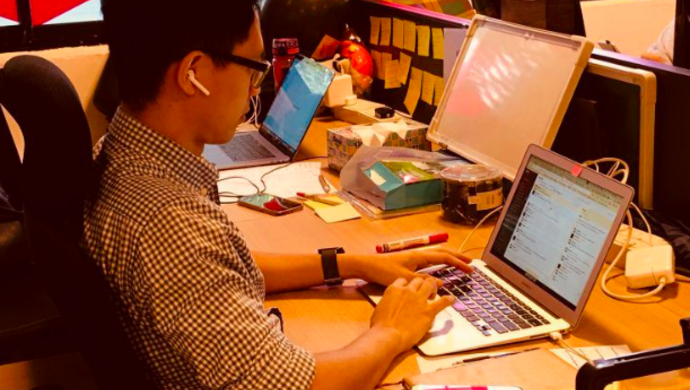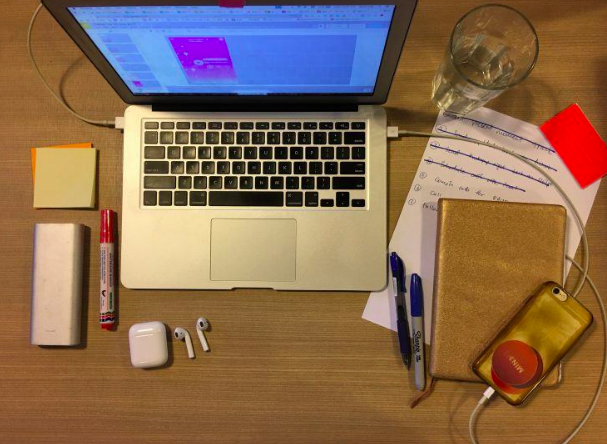Why be busy when you can be productive?

Work in an open office?
Too many meetings and events?
Can’t stop checking your phone?
Writing this article is ironic.
I know many people, including myself, who are guilty of spending more time reading about productivity than actually getting work done.
When we are unproductive, the chief culprit is our own mind: a hungry, voracious “toddler” that craves distraction.
While it’s hyper-productive in generating endless wants with limited stimuli, it’s unfortunately not productive in doing serious stuff. We may find ourselves with an entire hour to work, but if we see a cat video, our mind will get distracted and make us want to see more cats.
My main productivity rule is that it’s not about more time, but more attention⏤my preferred byword for discipline, willpower, focus, and concentration.
For our personal productivity system, I also believe that it’s less about the tools and more about the rules. First-world problems (e.g. our productivity) stem from abundance, not scarcity.
What matters is not access to more; rather, it’s how we filter the few.
Here are some ways we can prepare our brain to accept the tools that suit it best.
Social media is the new sugar
The first step?
Know thy enemy.
I can think of no finer founder than Slack CEO Stewart Butterfield to point out the problem of cognitive diabetes⏤that infinite loop of messages, emails, and notifications that impairs our mental abilities.
Let’s call a spade a spade: Social media is the new sugar.
It blocks our routines the way sugar clogs up our minds.
We need to start clearing this blockage; timebox your aimless browsing time.
Move social media apps inside a folder, then hide it a few screens away. Turn off push notifications for most apps, except important ones.
(At this point, I must stress that you do this, or any of my following rules, in gradual stages. Going cold turkey, like deleting your social media apps, won’t work. Ration it. Let your body and mind adjust.)
Routine = workflow + ‘lifeflow’
Mention “routine” and you might think “boring.”
But like it or not, humans are creatures of habit.
If you don’t have a fixed time, place, and sequence to work, the constant change in our physical and digital worlds will eat you up.
At my last job at Zendesk, we thought a lot about workflows of customer support teams.
When I did customer visits, what struck me wasn’t what they did inside our product, but what they did before, during, or after they use it.
The same applies to our work.
We need to think of the surrounding membrane of life activities, or “life-flow,” so productivity fits in naturally into our daily routine.
Think about the things you do before you actually start work⏤get coffee, play music, open laptop, then work.
Figure out this sequence so you fit into a seamless flow and, without much effort, comfortably land in work.
Shields up! Get into battle mode
Check in with my calendar and team to make sure no one needs me for the next hour or so.
Go to the restroom. Get water.
Wear earphones. Blast the same music.
Turn on Pomodoro timer app.
Turn on Do Not Disturb mode on phone (go Airplane Mode if you are hardcore). Put your phone face down so you won’t see it light up.
I swear this is literally my mini-routine when I really want to get stuff done; I call it my “deep work” mode, and it feels a lot like gearing up for war.
Sounds like a lot of work? Don’t be lazy.
That’s how you started reading this.

To-dos are baby food: shatter and downsize
Remember how I said our minds are like hungry, voracious toddlers that crave distractions?
This might be why to-do lists can be scary and our minds end up craving a sugary treat.
The trick is to imagine to-do lists as baby food: Break down a scary task into manageable bite-sized chunks. This lowers the fear factor and builds momentum.
Let’s say you are writing a monthly investor update and your metrics are shit.
Focus on the good news first. If that is still scary, come up with a micro-task such as creating a document and naming it “Monthly Investor Update.” Make this a task you write at the top of your to-do list.
Next, make the next micro-task “write two sentences.” Don’t care what they are and don’t edit them yet since you ain’t sending them.
Start your day feeling GREAT
Since young, many of us (especially males) are taught that emotions make us weak, but science has discovered that emotions play a significant role in our decision making.
This is why it is important to feel good at the start of your day.
Soften up your scary to-dos.
Prioritize a few micro-tasks at the top of your to-do list and bag a few quick wins. Even better, cross them off once done in the most satisfactory way possible, such as with a giant Sharpie marker or a big green tick.
Let the endorphins give your fuzzy mind a jolt of happiness!
Deadline yourself
If you hate happiness, go for its evil twin: fear.
We all know our worst enemy is ourselves. They all have the same name too: willpower (or rather, the lack of it).
My best work is done under a timeline.
Also Read: What I learned about procrastination while scaling my startup to 4.2M users
If you don’t have one, manufacture one. Promise a co-worker or your boss to deliver by a certain time. Make that person your accountability buddy.
Here, the scarier the better. Don’t get your good friend or partner who might just mollycoddle you. I use investors to scare myself into deep work.
Depending on your motivation style, pick the carrot or stick.
Train your mind: meditate
You must be sick of me comparing your brain to a baby by now, but that is why I meditate and built a meditation app, MindFi.
You may have heard of the “monkey mind,” or how much our conscious mind resembles an excitable child.
Fundamentally, meditation trains our minds’ attention muscle. It’s also why 80 per cent of successful leaders meditate (Tim Ferriss’ words, not mine).
For me, I meditate the moment after I wake up. No checking of overnight notifications, no social media, no bullshit.
Also Read: Startup of the Month, January: Vietnamese e-wallet service MoMo
I move from my bed to my chair (all about the routine!) and do my unguided meditation while tracking my EEG brainwaves with the Muse meditation headband.
While doing my routines throughout the day, I meditate or stay mindful with my eyes open.
No is the new Yes
In the age of FOMO, saying “no” is the new cool.
You’re only awake 16 to 18 hours per day; it would be a shame to spend most of them in aimless meetings.
Project updates, brainstorming, agenda-less meetings or just a plain “let’s grab coffee” are time wasters for you and the person you meet.
Restrict yourself to x amount of meetings per day. Ask politely for the agenda so you know how best to help them. Bunch meetings together by time. Locate them near each other to cut commute time.
The outcome?
Big chunks of uninterrupted time every day, for your own deep work or with your team. Every aimless meeting avoided is more time for your work.
I only take meetings at the very start or very end of my day. You will know if you are doing it right when you look at your calendar: a nice long uninterrupted streak of meetings within a condensed period of time (I love visual cues).
Paul Graham has an excellent article about this.
–
There are thousands of products that you can use to help with productivity.
So what if you know the tools that Elon Musk or Jeff Bezos use daily for work and life?
The best tools are only as good as the hands (or mind) that wield them.
—
e27 publishes relevant guest contributions from the community. Share your honest opinions and expert knowledge by submitting your content here.
The post 8 productivity hacks to streamline your work-life appeared first on e27.
Source: E27

